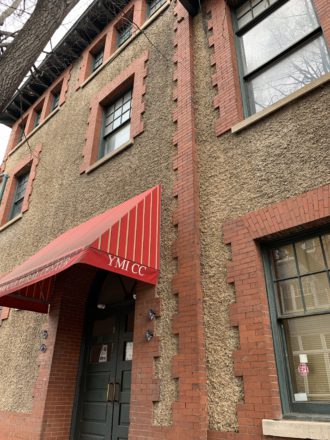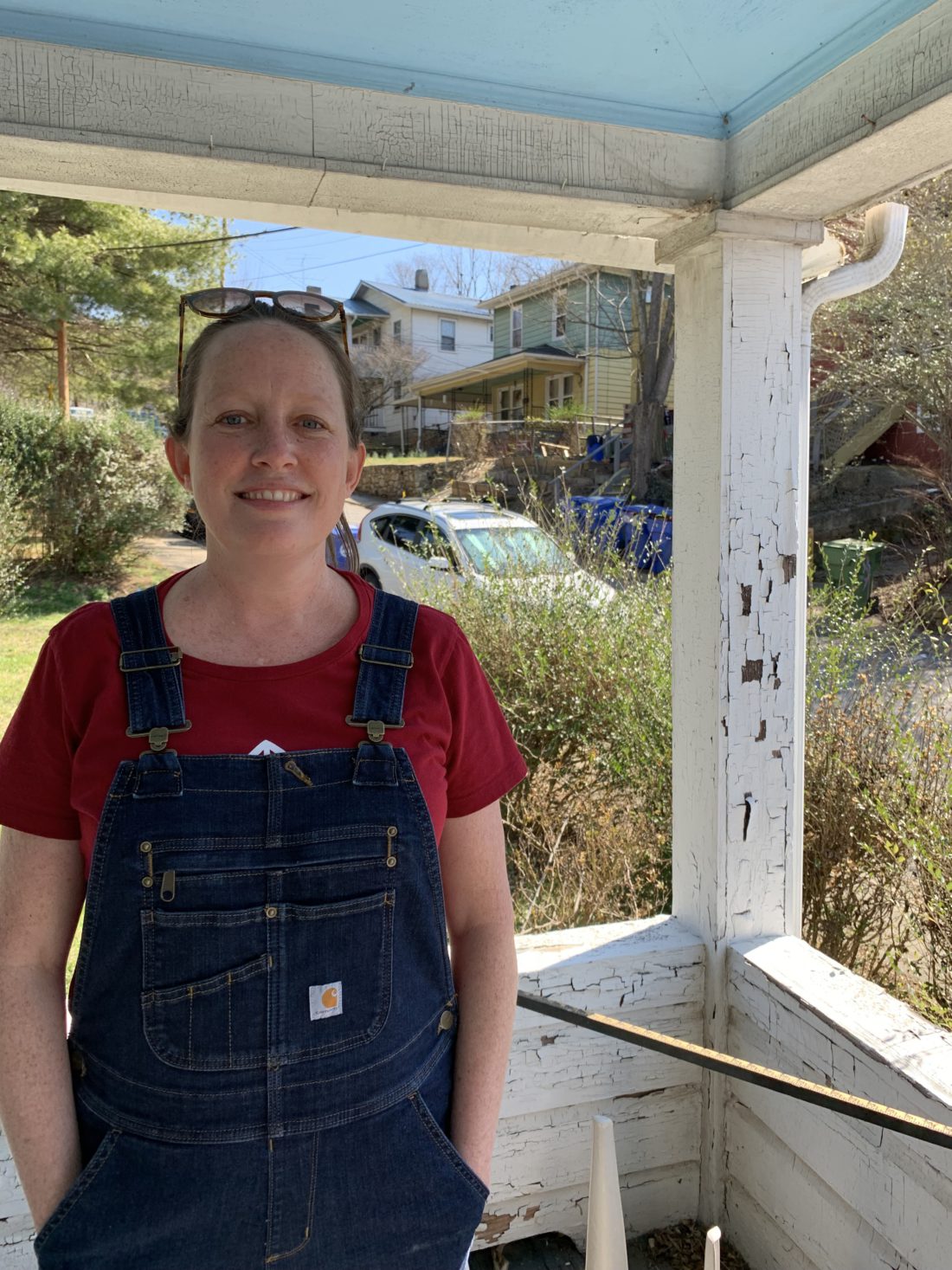As high-end housing and high-rise hotels continue to erupt across the Asheville landscape, some are instead working diligently to preserve buildings that are already standing. Quite a few historically significant structures are now receiving attention before they fall into what Jessie Landl, executive director of the Preservation Society of Asheville and Buncombe County, calls “demolition by neglect.”
“If these buildings don’t get refurbished soon, they’ll be too far gone to save,” says Landl, as she and her volunteer crew begin tearing through moldy drywall, dilapidated ceilings and overgrown bushes at the Cappadocia Fire-Baptized Holiness Church and an adjacent two-story house off Charlotte Street. The church was built in 1908 and rebuilt in 1926, while the house was built in 1910.
The two structures form an important part of the East End, a historic African American neighborhood on the western slope of Beaucatcher Mountain, known as Catholic Hill. The house fronts Grail Street, which Landl calls “one of the most intact streets in the neighborhood.”
PSABC purchased both structures in February for $420,000, Landl says. But that’s just the start of the spending. Bringing old buildings up to modern-day standards involves architectural assessments, electrical upgrades, plumbing revamps and structural repairs — challenges that many preservationists are now facing, and seeking to fund, as Asheville’s turn-of-the-century landmarks continue into their second hundred years.
“It’s not a coincidence that all these places are fundraising at the same time,” says Mary Everist, board chair of the Basilica Preservation Fund. The nonprofit works to preserve downtown’s Basilica of St. Lawrence, a Catholic church designed by Spanish architect Rafael Guastavino and completed in 1909. “Since so many of our historic structures were built around the same time, they’re all needing major repairs at the same time.”
Many hands
While Landl doesn’t know exactly how much renovations to the Cappadocia Church and neighboring house will eventually cost, she says PSABC sees huge savings when volunteers show up to work. On the first volunteer demo day, the nonprofit’s board president, Amy Hornaday, and her husband, Will, pull off layers of drywall and wallpaper in one of the house’s bedrooms, while finance and operations manager Jamie Moody strips siding from the church and other volunteers carry out pews and paintings to be donated elsewhere.
“I put the call out, and people just show up,” Landl says, as she instructs a new batch of volunteers about what shrubs need to be discarded and what ceiling panels need to go. In addition to that volunteer sweat equity, local engineering firm Medlock & Associates is donating the time to conduct a structural report. Landl says that document is needed before requests for proposals can go out for more in-depth renovations.
For needs that can’t be met through volunteers, the society primarily raises funds through grants, donations and its own house-flipping projects. For example, once work is complete on the Catholic Hill properties, Landl says the goal is for the church and house to be turned into affordable housing, with four apartment units in the church and the house as a single family residence.
It’s time
The Basilica of St. Lawrence, says Everist with the Basilica Preservation Fund, is in sore need of a new roof. She estimates that those repairs — made even more important by the church’s domed ceiling, among the largest free-standing elliptical domes in the country — will cost at least $2 million-$3 million. “If we don’t fix that, then there’s no use trying to preserve anything else,” she says.
The Basilica Preservation Fund’s overall fundraising goal at this time is $15 million-$18 million; in the “grand scheme of things, that isn’t that much,” Everist says. But she says that the downtown congregation is not particularly wealthy and would be unable to fund the work itself. (As an independent nonprofit formed in 2008 to support church upkeep and major repairs, the fund is separate from the parish’s religious leadership.)
Much of the wear and tear on the structure, Everist continues, comes from tourists, who often place the basilica on their must-see lists when visiting Asheville. She says the fund hopes to recoup some of those costs from visitors through more organized and impactful marketing efforts, such as placing donation boxes around the church, selling ornaments and offering more destination events.
Meanwhile, the fund has already paid six figures for a historical structure report, Everist says, which “represented a significant investment due to the national significance of the building and the complexity of the history and repairs.” Work included 3D mapping of the entire dome and a forensic engineering examination of the architectural structures.
For locals and tourists

Built in 1893, the YMI Cultural Center is undertaking a capital campaign to raise $6.2 million for renovations to its downtown Asheville building in the heart of The Block, another historic African American community. In June 2021, the nonprofit received a National Park Service Grant for $500,000, and the group itself has raised an additional $1.75 million through donations to renovate the 18,900-square-foot building, says Phillipe Rosse, an outside contractor hired to lead the campaign. Another $3.6 million in grant requests remains outstanding with the city of Asheville, Buncombe County and the Dogwood Health Trust.
YMI Executive Director Dewana Little says fundraising will continue with major corporation and individual donor campaigns, as well as the renewal of a membership program the organization dropped in the late 1990s. “I also am excited about legacy building with our brick campaign,” Little says.
Construction is slated to begin in April and run through November. The YMI’s staff, which has continued to serve the community with a myriad of social and educational programs such as after-school tutoring, workforce development training and peer support, will move into temporary offices throughout the city so that the renovations can be completed all at one time.
When the work is complete, the community will have access to four floors of programming, event and meeting facilities, as well as more space open to the public for tours. The basement — which once held a swimming pool, sleeping rooms and even a morgue — will boast the majority of new usable space and feature complete Wi-Fi connectivity.
First Baptist Church on Oak Street in downtown Asheville, designed by architect Douglas Ellington and completed in 1927, is another historic landmark joining the fundraising fray. Church leaders will kick off a congregational capital campaign in April, with hopes to raise $3 million for work on the original bricks and ornamental terracotta on the outside of the church, as well as roof, dome and floor repairs inside the sanctuary, says the Rev. Mack Dennis.
Dennis says that his church hosts a wealth of visitors who can contribute to the overhead needed to repair and restore the historical structure. “We see people at least once a week who meander in from the parking lot, wondering what this place is. They’re often surprised that it’s just a Baptist church,” he says with a laugh.
He also hopes to raise awareness and funds through the musical programs the church supports through its Academy for the Arts, enrollment in its child development center, special event rentals and limited debt.
National recognition
Some outside support for historic preservation in Asheville is already on the way. First Baptist and the Basilica of St. Lawrence each won a $250,000 grant from the nonprofit National Fund for Sacred Places in 2020. The grants require a 2-to-1 match, or $500,000, from the grant recipients.
Rachel Hildebrandt, director of the Philadelphia-based organization, says the churches will receive half of that money once they’ve met certain planning and fundraising benchmarks, with the remainder coming once work is complete. She adds that it’s unusual, given the nonprofit’s national scope, to award two grants to churches in the same city in the same year.
But she notes that both First Baptist and the basilica came to the National Fund with very compelling cases. “Both steward tremendously significant buildings with urgent capital needs,” Hildebrandt says. “And both use their property assets to serve the city of Asheville and its peoples. These congregations checked every one of our boxes, so we made an exception and accepted both into the program in 2020.”
“This is such a testament to Asheville,” adds Dennis. “They don’t hand this money out like party favors. It’s obvious that these structures are a source of pride. And this isn’t just a grant to facilitate the building, but a gift to open our churches and reimagine the spaces for the greater community.”
Editor’s note: The online version has been updated for additional clarity about the Grail Street neighborhood and the Preservation Society’s plans for the properties.



Before you comment
The comments section is here to provide a platform for civil dialogue on the issues we face together as a local community. Xpress is committed to offering this platform for all voices, but when the tone of the discussion gets nasty or strays off topic, we believe many people choose not to participate. Xpress editors are determined to moderate comments to ensure a constructive interchange is maintained. All comments judged not to be in keeping with the spirit of civil discourse will be removed and repeat violators will be banned. See here for our terms of service. Thank you for being part of this effort to promote respectful discussion.